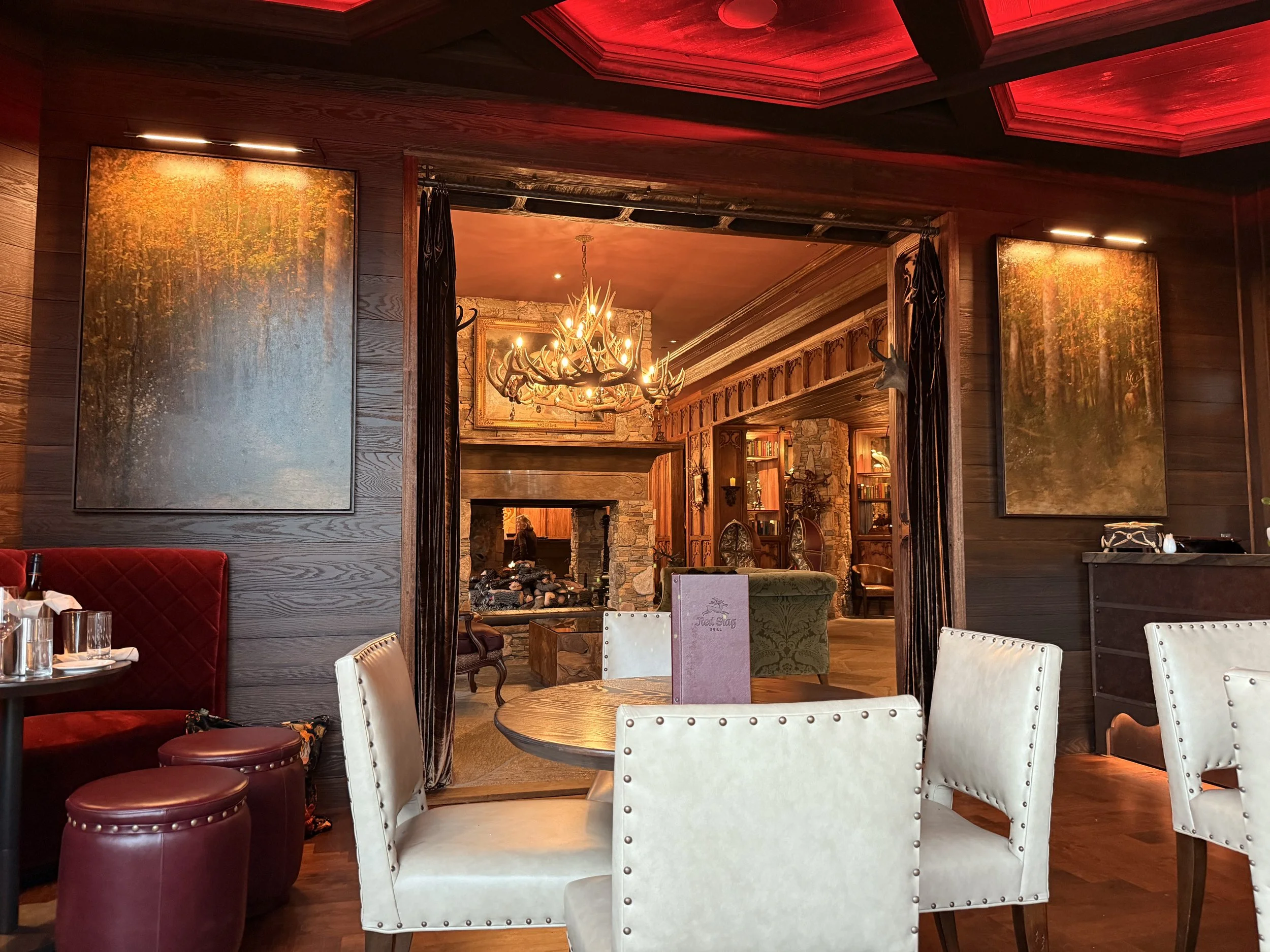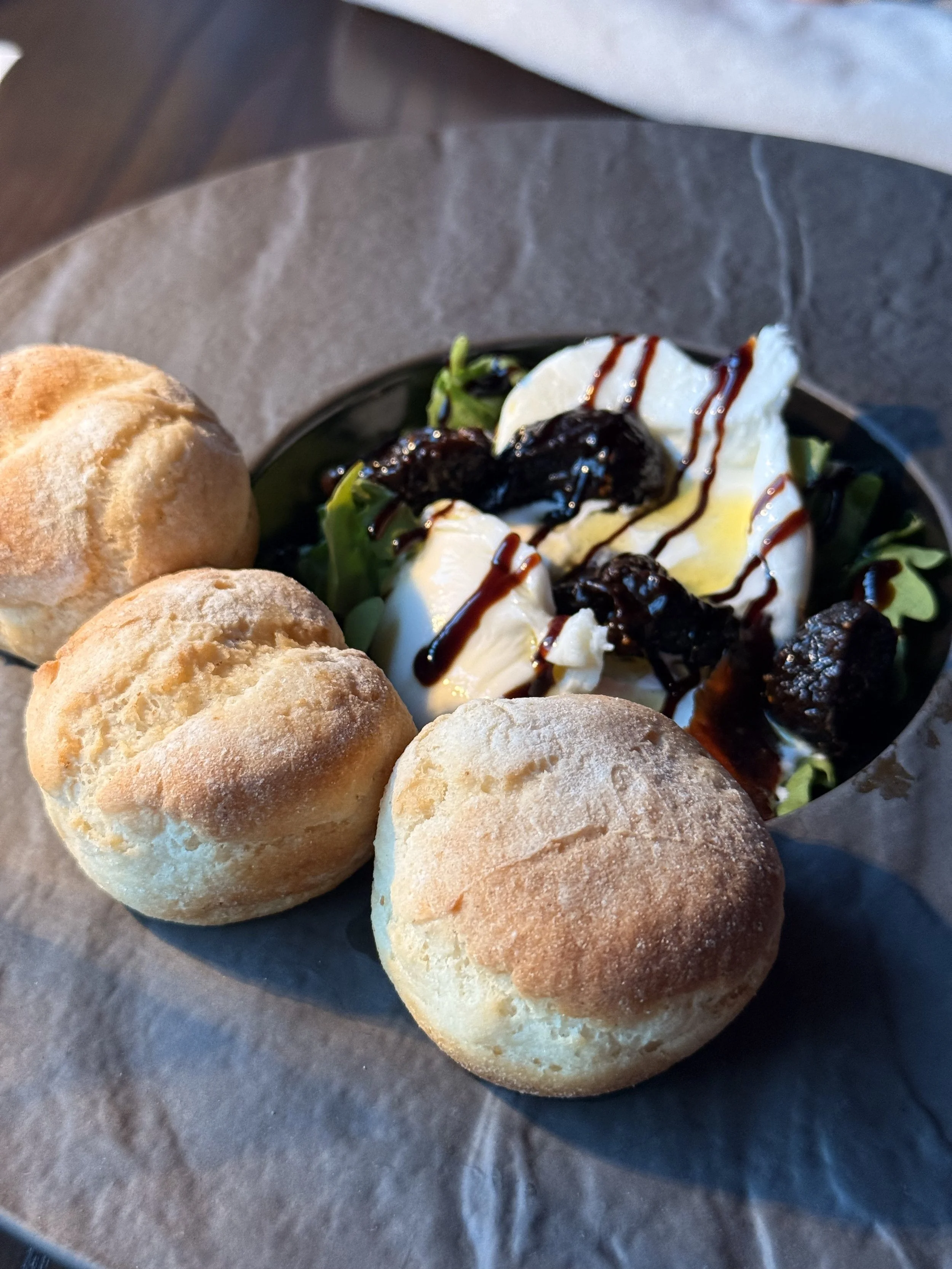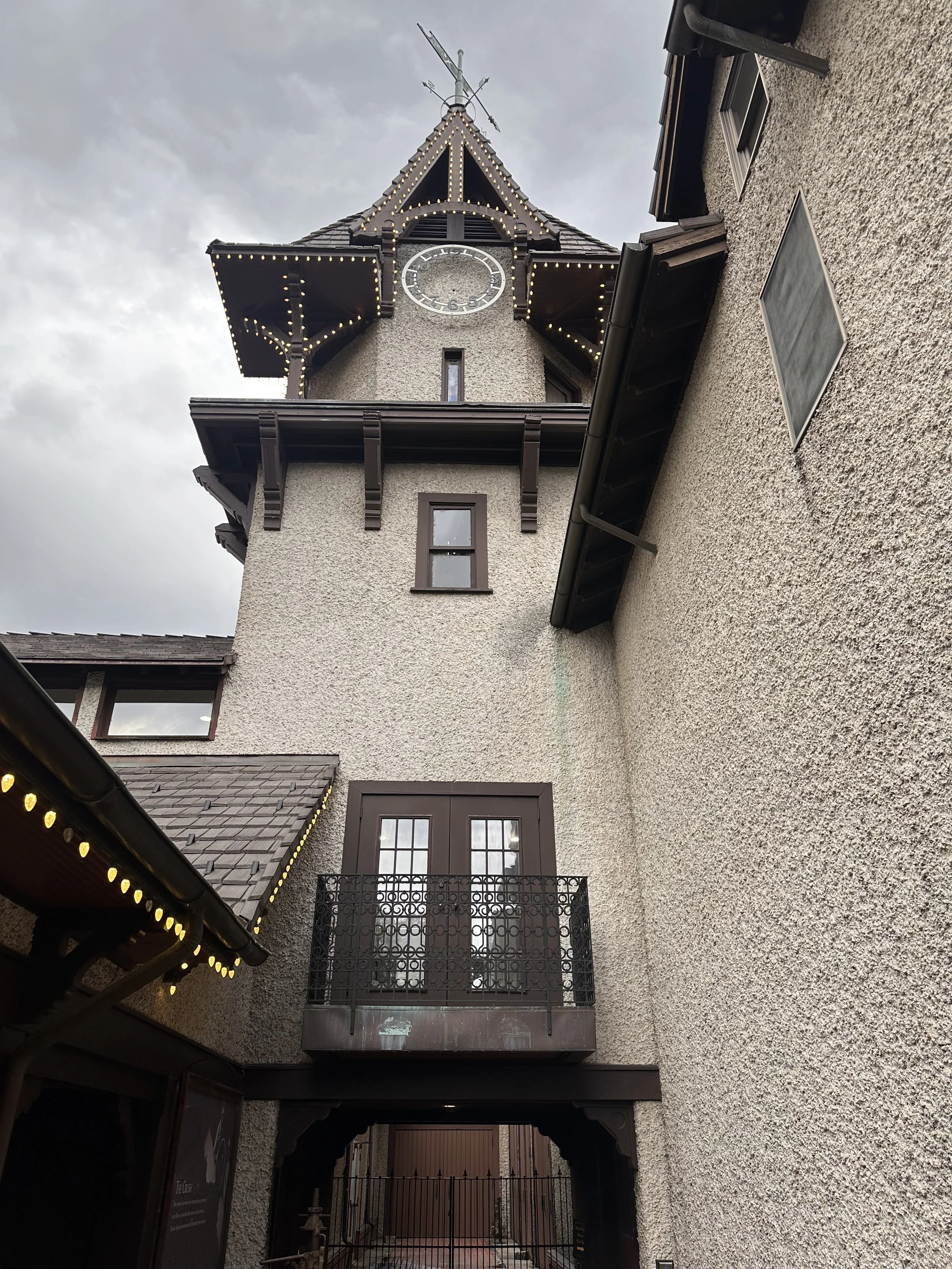Exploring Asheville, NC
Time needed in this town: 2 NIGHTS
At the end of September, my husband, dog, and I started making our way across the country to move back to Arizona. Instead of spending long days in the car, we chose to make this into a fun roadtrip for all of us, which included visiting Asheville, NC - a place that is slowly recovering from Hurricane Helene.
While there is still a lot of work to be done, there’s enough to do for a weekend, especially if you’ve never been to the Biltmore and they absolutely need the tourist money.
The below information is a complete guide of the best places to stay, the top rated places to dine and drink, and all there is to see and do. We’ve also included a summary of the history of this awesome little town!
Jump To:
Where to Stay
Talk about a lovely stay at such a grand and pet-friendly hotel! Located in Biltmore Village, Grand Bohemian Lodge did an amazing job recovering/renovating after being submerged in nearly 20 feet of water a year ago, from Hurricane Helene. Having initially been built in 2009, you’d have no idea it was a modern-day build with ornate wood work, the worn look of the stone floor, and the façade of the buildings looking even older than that.
Rooms: The rooms, themselves, are comfortable and beautifully decorated (especially the bathrooms - every detail is exquisite, including the toilet and shower doors that look like thin sheets of ice). We stayed on the Manor side, which is quieter in terms of overall hotel noise, but is exposed to more street noise, especially at night.
Pet Perks: There is a hefty pet fee that comes with staying there, though your furry family member gets some additional perks because of it, including a plush bed, a collapsible water bowl, a bandana, and a waste bag holder (with bags included). They also get access to the art gallery, as well as the Red Stag Grill Lounge and all common areas. Note that while there isn’t a dedicated pet relief area, there is a lot of grass nearby just steps away.
Location: Biltmore Village is currently rebuilding. What does that mean? It means not every shop and restaurant is open however, quite a few are. We actually found it fascinating to walk around and see the remnants from the hurricane, including historical buildings waiting on renovation permits, buildings that still need to be demoed, and buildings that are currently in the process if being renovated/rebuilt.
Other Places to Stay
Cambria Hotel (Downtown Asheville)
Cedar Crest Inn (near Biltmore)
Haywood Park Hotel, an Ascend Collection Hotel (Downtown Asheville)
Kimpton Hotel Arras by IHG (Downtown Asheville)
The Flat Iron Hotel (Downtown Asheville)
The Inn on Biltmore Estate (Biltmore)
The Radical Asheville, Tapestry Collection (Downtown Asheville)
The Restoration (Downtown Asheville)
The Windsor Boutique Hotel (Downtown Asheville)
Village Hotel on Biltmore Estate (Biltmore)
Zelda Dearest (near Downtown Asheville) - TOP RATED!
Where to Dine & Drink
Azalea Bar & Kitchen (Near biltmore village)
Easygoing Southern-influenced eatery dishing up farm-to-table meals, plus wine & beer.
Cedric’s Tavern (Biltmore Estate - Antler’s Hill)
Chestnut (Downtown Asheville)
New American eatery for seasonal bites & homemade treats in restored 1920s digs with a full bar.
Corner Kitchen (Biltmore VillaGE)
Set in a Victorian cottage with a patio, this upscale venue serves New American fare & craft drinks.
Cúrate Bar de Tapas (Downtown Asheville)
Traditional Spanish tapas
Farmese Cocktail Lounge
They provide curated craft tastings, trendsetting new techniques and ingredients, live house music from tenured DJs, all served up in a very vibey underground Asheville setting.
FLour
Coffee and breakfast spot with homemade biscuits and pastries.
guajiro (Near biltmore village)
Authentic Cuban cuisine
Laila Asheville (Downtown Asheville)
Modern Indian Cuisine
Luminosa (Downtown Asheville)
Modern Appalachian meets Italian wood-fired cuisine.
Old Europe Pastries (Downtown Asheville)
Old-world coffee shop offering locally roasted brews along with various European-style pastries.
Pollen coffe + flower shop (Downtown Asheville)
A cafe and flower shop in one!
Posana downtown (Downtown Asheville)
Contemporary American cuisine featuring local ingredients served in a chic space with a patio.
Red Ribbon Society (Downtown Asheville)
Set in a former boiler room with the original door preserved, the speakeasy's name nods to Prohibition-era red ribbon markers. The dimly lit corridors add to the experience and honor the building's history and its heating engineer.
NOTE: It is the in the basement of Luminosa.
Red Stag Grill (Biltmore village)
We were staying at the Grand Bohemian Lodge, which made this a convenient (and perfect) choice for our dinners. We loved that the lounge portion of the restaurant was dog-friendly, so much so that waiters were sneaking him bacon and other treats where they could. For humans, they had an abundance of gluten-free options, including some incredible rolls (that were awesome with the burrata we had), as well as a fantastic wine and cocktail list.
Rowan Coffee (Downtown Asheville)
A coffee shop that also serves fresh pastries.
The Daily Grind (Biltmore Village)
Coffe and pastry shop.
The Times bar & Coffee Shop (Downtown Asheville)
Chandelier-lit, vintage-style bar in a historic building for cocktails & coffee.
Things to See & do
BILTMORE ESTATE
ANTLER HILL VILLAGE
Per their website, “Included with admission, a visit to Antler Hill Village® is the perfect way to extend your Biltmore experience. A vibrant hub of activity that connects the estate’s past and present with dining, shopping, exhibits, and our Winery, plus our Farmyard, Bike Barn, and Pisgah Playground, the Village has something for everyone.”
Our take: It’s great for a couple of hours. There are a couple of good restaurants, great places to relax and sip wine, as well as shops to browse.
NOTE: Dogs are allowed on patios and on the grounds only.
Biltmore house
The history of the Biltmore House is fascinating. I’ve included a quick summary, derived from their website:
1888 - George Vanderbilt began purchasing land, eventually acquiring a total of 125,000 acres. His vision was a country estate modeled after European traditions, symbolizing wealth, land ownership, and the importance of family.
1889 - Construction on the estate began. It was meant to be a country retreat, after George Vanderbilt fell in love with the area's natural beauty and mild climate. Vanderbilt enlisted architect Richard Morris Hunt to design the 250-room Biltmore House and landscape designer Frederick Law Olmsted to create the grounds. .
1895 - The estate opened to family and friends on Christmas Eve.
1898-1900 - George Vanderbilt married Edith Stuyvesant and their only child, Cornelia Vanderbilt, was born in 1900. In that same year, the construction of the main dairy and horse barn begins.
1914 - George Vanderbilt died leaving his wife, Edith, and daughter, Cornelia, to manage the estate, though 87,000 acres were sold off to the United States Forest Service.
1924 - 1928 - Cornelia married John Francis Amherst Cecil and together, they had two sons, George (born 1925) and William (born 1928).
1930 - Cornelia and John Cecil opened the home to the public to increase tourism during the Depression, as well as generate income for the estate.
1942 - During WWII, the house stores priceless works from the National Gallery of Art in Washington, DC.
1960 - Leaving his banking career in New York, William Amherst Vanderbilt Cecil joins his brother, George, in managing the estate, focusing on self-sufficiency and preserving the estate’s historic splendor.
1963 - Biltmore House is formally recognized on the National Historic Registry.
1971 - William Cecil plants his first grape vines just below Biltmore House.
1983- 1985 - Construction begins on a new state-of-the-art winery in what had been the estate’s dairy barn. Mr. Cecil’s son, William (Bill) A.V. Cecil Jr. assumes leadership of the renovation. Two years later, in 1985, the winery opens to the public.
2001 - The Inn at Biltmore Estate opens.
2005 - The Market Gardener’s Cottage (built in 1897) is the first of the Cottages on Biltmore Estate, open to overnight guests.
2010 - Antler Hill Village opens
2015 - Village Hotel on Biltmore Estate opens.
2021 - 2022 - Two more cottages on the estate open for overnight guests.
Today, the Biltmore Company remains family-owned, with the fourth and fifth generations of George Vanderbilt's descendants continuing to operate and preserve the estate.
My experience: It was unbelievable. Having toured manors, castles, and chateaus all over the world, this was. by far, one of the greatest homes I’ve ever seen. The level of artistry in every room, how it was laid out to accommodate family, guests, and staff; the incredible amount of invention to support efficiency, and all of the adventures you can have in and on the property just makes it a spectacular place to visit.
TIP #1: Go at Christmastime for a magical experience!
TIP #2: If you can afford it, stay at their five-star Inn.
TIP #3: Get a private tour to get access to hidden doors and private rooms!
NOTE: Dogs are allowed on the grounds before the security checkpoint.
The REST OF ASHEVILLE
Asheville Art Museum
Established by artists and incorporated in 1948, the Asheville Art Museum is committed engaging, enlightening, and inspiring individuals and enriching community through dynamic experiences in American art of the 20th and 21st centuries.
The newly renovated 54,000-square-foot building opened in November 2019. The Museum presents a robust schedule of 15 to 20 engaging exhibitions throughout the year.
Asheville pinball museum
Located in the old Battery Park Hotel, the Asheville Pinball Museum has over 30 vintage tables (the oldest is 1940) and more than 20 classic video arcade games to play for one entry fee!
Basilica of St. Lawrence
Designed in 1905 by the Spanish architect Rafael Guastavino (who came to Asheville to work on Vanderbilt’s Biltmore Estate), the Basilica of St. Lawrence is constructed in Guastavino’s signature Spanish Renaissance Revival style, an ancient building method from Catalonia that the Spanish architect revived and brought to America. It uses masonry materials such as stone, brick, tile, and mortar exclusively—there are no wooden beams or steel in the entire church foundation. In fact, it has one of the largest free-standing elliptical domes in the U.S.
Inside, highlights include Italian-made statues, beautiful stained glass windows from Germany, and a frescoed high altar cut from Tennessee marble.
The church was opened in 1909, a year after Guastavino’s death (he is entombed in a crypt there).
In 1993, the Pope gave it basilica status.
Biltmore Industries Homespun Museum
Founded in 1901, Biltmore Industries was established to teach the children of the estate staff a useful craft that could earn them a living both then and in the future, specifically woodworking and weaving, which were taught by a pair of artisans, Eleanor Vance and Charlotte Yale, with the financial backing of Edith Vanderbilt.
Within the first decade, the high-quality homespun fabrics they created became the school's premier products as they were world-renowned for their high-quality, with many famous Americans wearing their garments.
By 1917, the wealthy industrialist Fred Seely bought the school, and it became a full-fledged business. It grew to 40 looms, producing 700 yards of fabric per day and employing as many as 100 workers at its height in the 1920s.
What set it apart was the Appalachian air - all the wool was hung up in the dry mountain breeze, ensuring any shrinkage occurred before it was sent to the tailor. The skilled workers would take great care threading the intricate patterns, which could take hours to perfect.
While demand dropped off in the 1940s, production continued up until 1981, when the factory shut down. Today, the Dye House has been preserved, with wool still in the looms. Much of the original equipment and machines, including a rare antique four-harness loom, are now on display at the Biltmore Industries Homespun Museum, along with many fabrics and suits.
The small museum is located in Grovewood Village, at the site where Biltmore Industries was moved in 1917.
Estes-Winn Antique Car Museum
Per their site, “Established in 1966, this historic attraction was founded by local legend Harry D. Blomberg, Asheville’s Cadillac-Pontiac dealer for over half a century and founder of modern-day Harry’s On The Hill. The museum features Harry’s prized collection of antique and vintage automobiles, including a rare 1957 Cadillac Eldorado Brougham and Asheville’s own 1922 American LaFrance fire truck.”
Flat iron sculpture
In 1997, Artist Reed Todd, a local to Asheville, created a cast iron, iron sculpture as a tongue-in-cheek nod to the early 20th century flat-iron architecture. Asheville got their own flat iron building in 1927.
The Flat Iron sculpture, honoring this iconic building, was installed on Battery Park Ave to celebrate Asheville’s historic past, as well as its modern evolution as a hip contemporary city filled with a vibrant art scene.
The sculpture rests on the sidewalk and belongs to the Asheville Public Art Collection. It’s a popular spot for street artists and performers.
Hike Mount Mitchell
At 6,684 feet tall, hiking the Mount Mitchell Trail is no easy feat. It is 5.6 miles one way and is a strenuous hike.
If you’re more of a “walking enthusiast” like me, there are other shorter and easier hikes on Mount Mitchell as well: The Commissary Trail, which is 2.2 miles one way and rated “easy”; and the Old Mitchell Trail, which is 2 miles one way and rated “moderate”.
There is also a free observation deck at the summit of Mount Mitchell that you can drive to for panoramic views, if you don’t want to hike.
The Grove Park Inn (NOW THE OMNI)
FUN FACT: In mid01955, a contract between the U.S. Supreme Court and the Grover park Inn was inked that stated, in the event of a nuclear attack on Washington, D.C., the Supreme Court is to decamp for the mountains of North Carolina, at the Grove Park Inn. Here, the court was to reestablish "normal court proceedings" and issue rulings.
While this seems unusual, each branch of government (and several departments) had also set up independent and redundant continuity of government facilities for the sole use of their employees. Congress built the Greenbrier bunker, White House civilians took Mount Weather, the military excavated Raven Rock, etc.
Half a century has passed since the four-page contract was penned with the Grove Park Inn, and the Cold War history sleuths at CONELRAD dug up Grove Park’s copy in a hotel filing cabinet in 2013. Lacking a sunset clause, it remains legally binding to this day.
NOTE: This is now an Omni property. If you visit, make sure to take a swim in one of their underground pools to find out which one plays music when you’re submerged.
A History Summary
Prior to 1540, the Cherokee Indians used the land that is now Asheville as hunting land and meeting grounds.
1540 - A town at the site of the river confluence was recorded as Guaxule by Spanish explorer, Hernando de Soto, during his 1540 expedition through this area. His expedition comprised the first European visitors, who carried endemic Eurasian infectious diseases that killed much of the native population.
1784 - Europeans began settling in the area.
1790 - The U.S. Census of counted 1,000 residents in the area, excluding the Cherokee Native Americans as a separate nation.
1792 - Buncombe County was formed.
1797 - Morristown was incorporated and renamed "Asheville" after North Carolina Governor Samuel Ashe.
1800 - The population was 5,812.
1861 - After the Civil War, the population decreased to 2500.
1865 - The "Battle of Asheville" was fought at the present-day site of the University of North Carolina at Asheville. Union forces withdrew to Tennessee, which they had occupied since 1862. They had encountered resistance in Asheville from a small group of Confederate senior and junior reserves, and recuperating Confederate soldiers in prepared trench lines across the Buncombe Turnpike. The Union force had been ordered to take Asheville only if they could accomplish it without significant losses. In late April of that year, North Carolina Union troops from the 3rd North Carolina Mounted Infantry, under the overall command of Union Gen. George Stoneman, captured Asheville. After a negotiated departure, the 2,700 troops left town, accompanied by "hundreds of freed slaves"
1880 - 1894 - The Western North Carolina Railroad completed its line from Salisbury to Asheville, the first rail line to reach the city. Almost immediately it was sold and resold to the Richmond and Danville Railroad Company, becoming part of the Southern Railway in 1894.
1889 - Asheville had the first electric street railway lines in the state of North Carolina and also started installing telephones. In addition, Biltmore Estate began construction.
1890s - Asheville developed steady growth as industrial plants increased in number and size, and new residents built homes. Textile mills were built to process cotton from the region, and other plants were set up to manufacture wood and mica products, foodstuffs, and other commodities.
1900 - Asheville was the third-largest city in the state, behind Wilmington and Charlotte. Its economic growth exploded. Religious assemblies, an opera house, and a convention auditorium drew urban culture to the area. The "Asheville Board of Trade," developed by the Chamber of Commerce in 1900, devised national advertising campaigns labeling Asheville one of "the leading convention cities in the country."
1912 - The Langren Hotel opened.
1913 - The Asheville Masonic Temple was constructed and Grove Park Inn opened.
1916 - The Asheville area was subject to severe flooding from the remnants of a tropical storm which caused more than $3 million in damage.
1918 - The Kennilworth Inn opened.
1929-1977 - Both the city and Buncombe County had incurred over $56 million in bonded debt to pay for a wide range of municipal and infrastructure improvements, including City Hall, the water system, Beaucatcher Tunnel, and Asheville High School. Rather than default, the city paid those debts over a period of fifty years. In 1977 - they were debt-free.
1930s - The Great Smoky Mountains National Park and Blue Ridge Parkway were established.
1930 - Eight local banks failed. Only Wachovia remained open with infusions of cash from Winston-Salem.
1934 - Buses replaced the electric railways.
1959 - Plans were approved to build an airport.
1968 - The last passenger train to serve Asheville was in this year - a coach-only remnant of the Southern Railway's Carolina Special.
2004 - remnants of Hurricanes Frances and Ivan caused major flooding in Asheville, particularly at Biltmore Village.
2024 - Hurricane Helene caused catastrophic, record-breaking flooding of the French Broad and Swannanoa rivers, devastating Asheville and surrounding areas of Western North Carolina.






